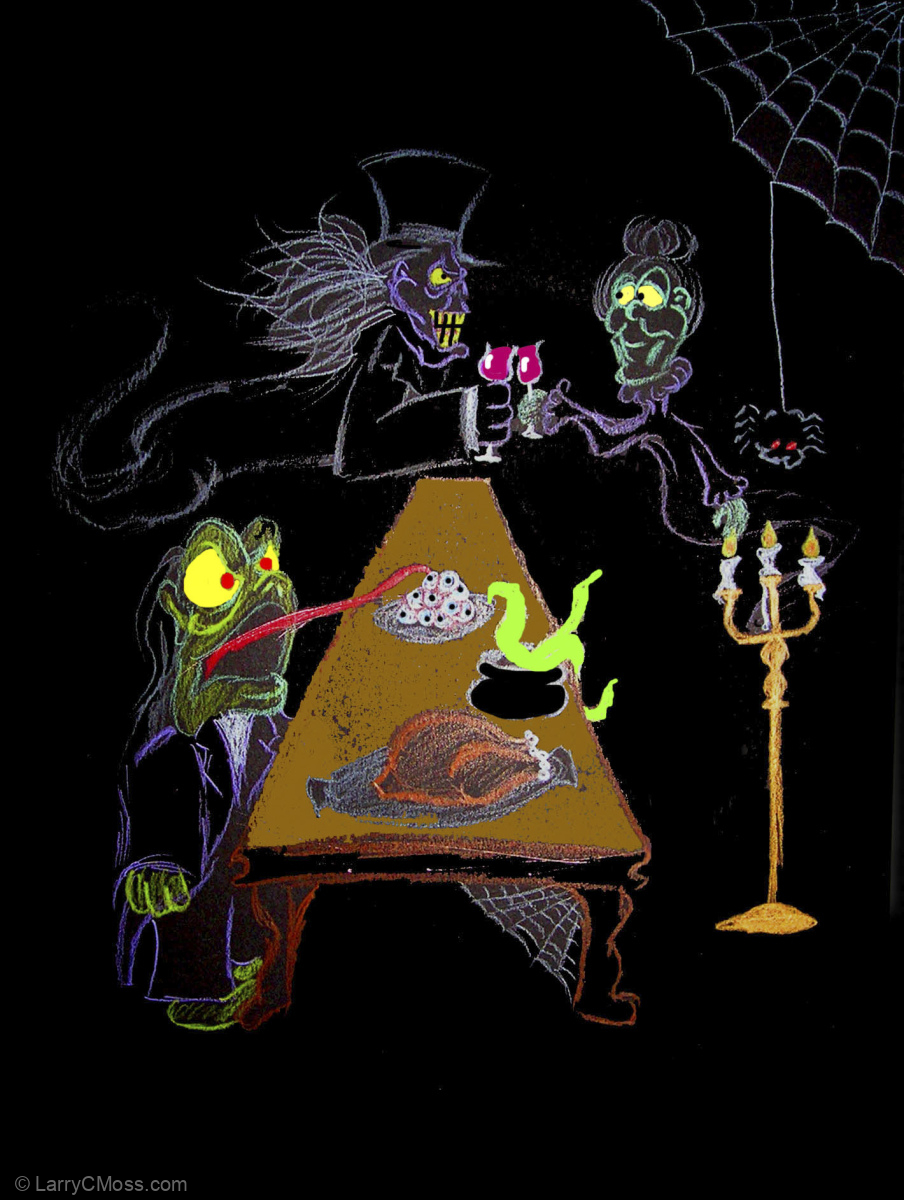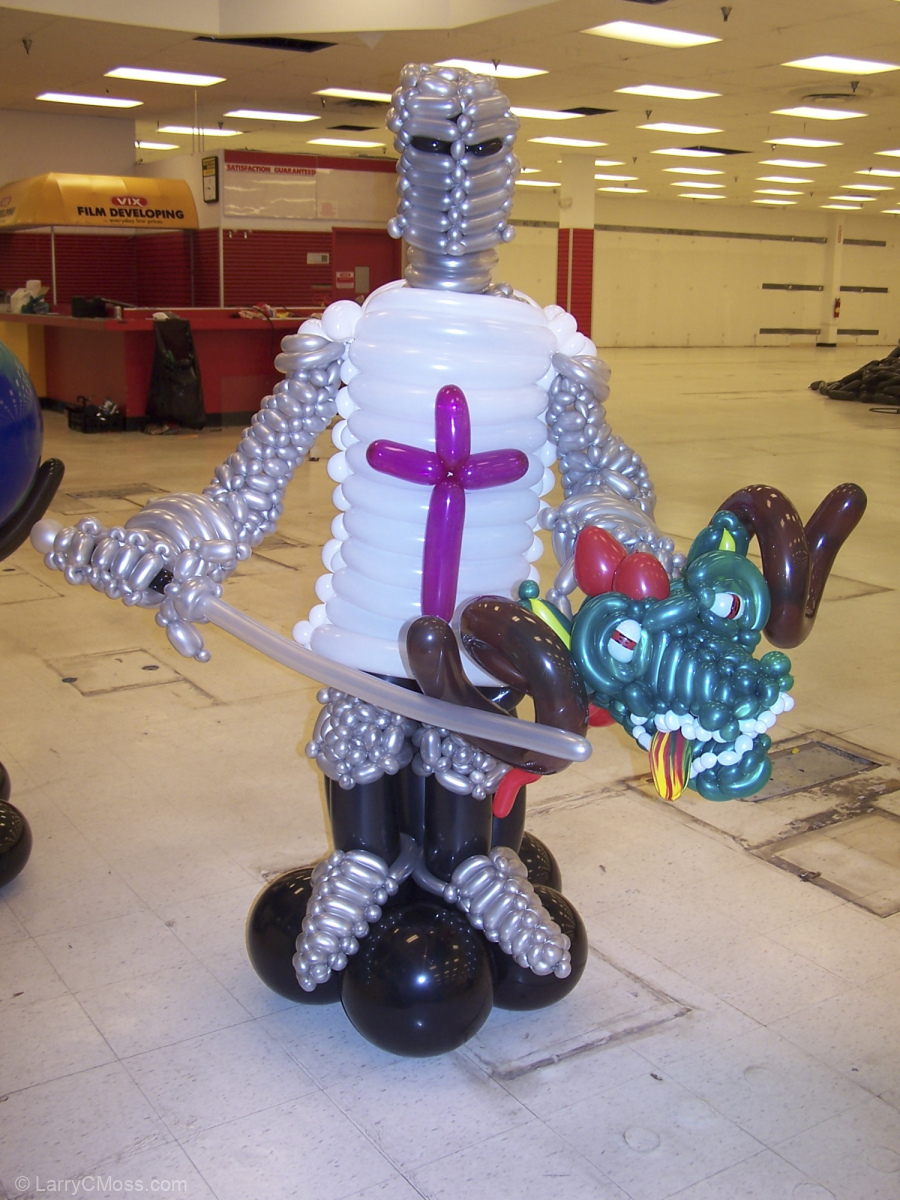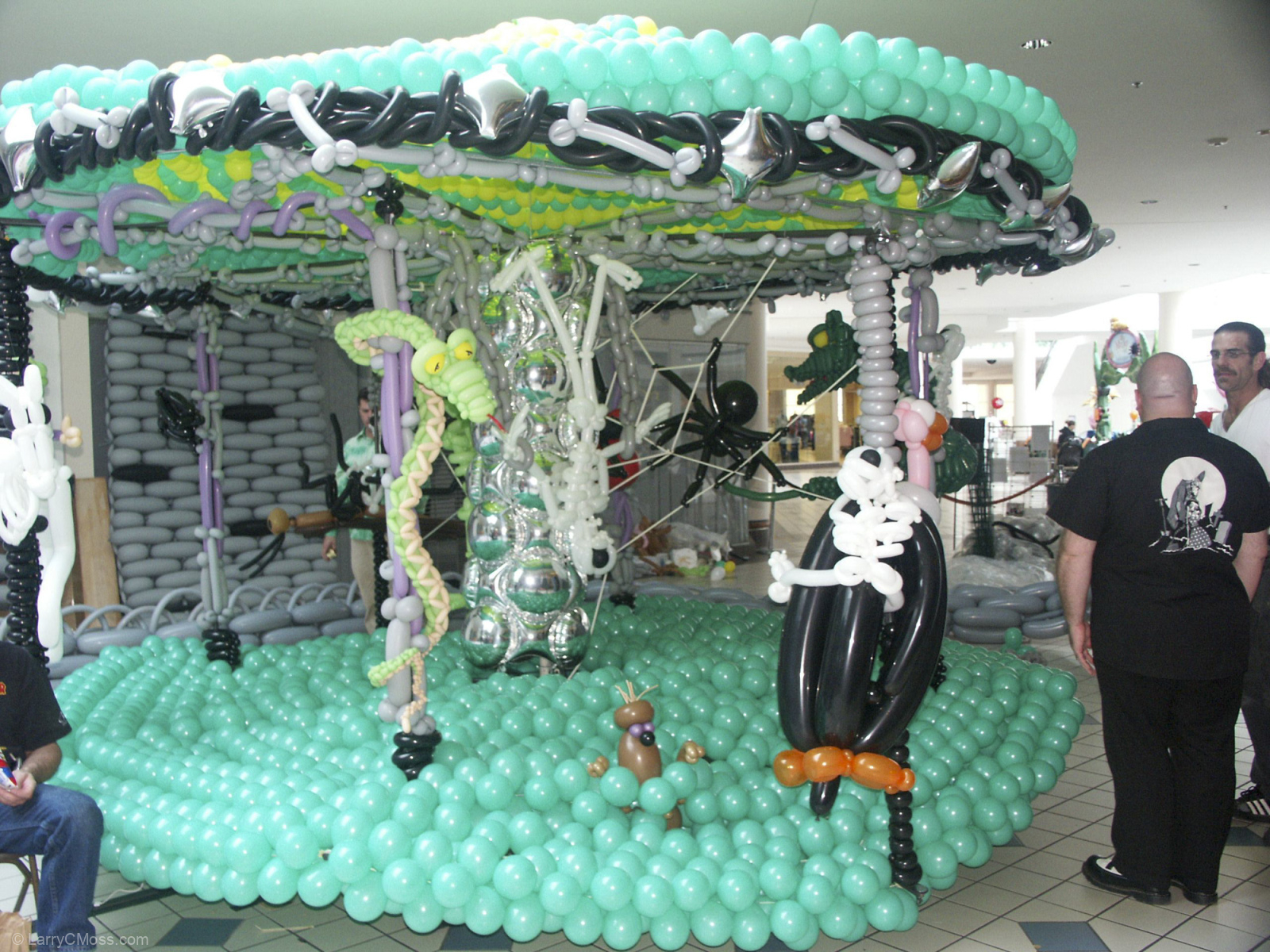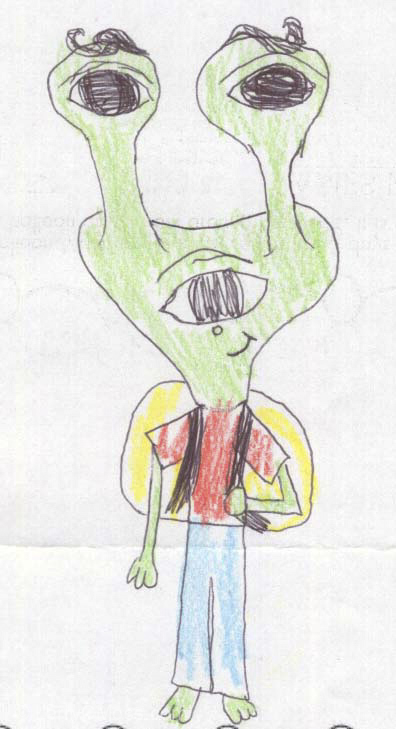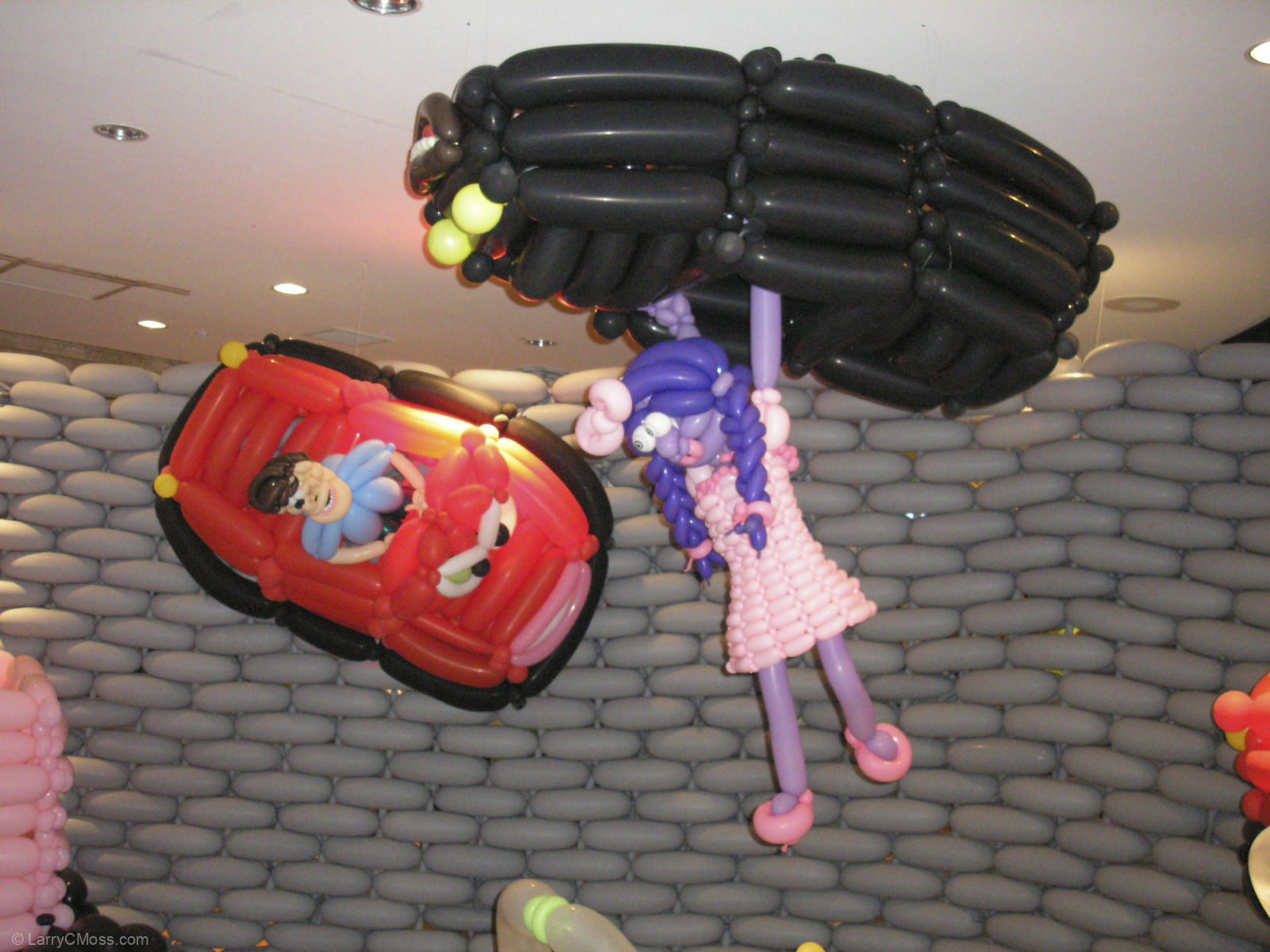Every grand project starts with a crazy idea. Sometimes it’s sparked by ambition. Sometimes it’s ego. In my case, it was a conversation with my first wife, Judy, while she was in a coma.
Back in 2003, Judy had just given birth to our enby when she was diagnosed with Hodgkin’s Lymphoma. “One of the most curable forms of cancer,” the doctors said. But “curable” can take you on some wild detours. A series of complications led to a traumatic brain injury and coma. While Judy was unconscious, the doctors advised, “Keep talking. You never know what she’ll hear.”
So I did. I talked about everything: the baby, the weather, what the rabbits were doing. And somewhere in the random babble, I promised her an anniversary gift unlike any other. I offered her a haunted house made entirely out of balloons. We were married on Halloween, after all. It was on-brand.
She eventually woke up. When she regained the ability to speak, one of the first things she asked was, “Did you promise to build me a haunted house, or did I just imagine that?”
She didn’t imagine it. And now, I had a deadline.
In 2004, the first Balloon Manor rose up in an empty storefront in Henrietta, NY. A 10-room, 10,000 square foot, silly, creepy, funny, weird, slightly haunted castle built entirely from latex balloons. The story we told was that of a grand castle and the creatures within, cursed to become nothing but air-filled shells of their former selves. The inhabitants included cheerful balloon ghosts, grinning ghouls, and one very energetic Not-So-Grim Reaper. We called it Scarigami.
The Manor was built by a community of volunteers and artists from around the country, each twisting, tying, and inflating their way through sleepless nights and aching hands to bring the vision to life. Over 50,000 balloons were used in the build. We had monsters. We had haunted rooms. We had castle walls made of inflated bricks and bushes made from lime green pencil balloons. More importantly, we had people coming together to build joy out of thin air.
People showed up. Lots of people. The Manor became something we repeated three more times. We skipped a year after the first one to regroup, but the monsters were just too charming to stay away. In 2006, monsters returned, by their choice this time (as the story goes), and turned their creepy old haunt into a “Dead & Breakfast” for guests from around the world.
In the years that followed, the Manor grew stranger and more ambitious. In 2007, it became Elastic Park, the world’s first balloon-based dinosaur theme park. In 2008, it transformed into SCARE U, a frightful university complete with classes in Anti-Social Studies and Under-World History.
Every iteration brought new rooms, new monsters, and new reasons for your jaw to hit the floor (usually from awe, not terror—we promised the Manor would always be family-friendly). Even our late-night “scary” version was more suggestion than actual scare. Basically, we dimmed the lights and added a few fog machines.
But no matter the theme, the mission remained the same: to create something ephemeral and unforgettable, raise awareness about serious illness, and support cancer-related charities like the James P. Wilmot Cancer Center and Teens Living with Cancer (now 13Thirty Cancer Connect).
Concept art created by Buster Balloon early in our planning discussions.
OG Balloon Manor (2004)
I didn’t know how big it was going to be. It was an idea. A promise to Judy. I figured I could count on a few friends to help with something fun. I called Buster Balloon. While constructing the Flying Octopus, Buster had talked about his days working on and in haunted houses, and idly suggested we create a haunted house out of balloons. Clearly he needed to be a part of this. From design work to execution, to promotional drawings, Buster was key to making this a reality. This was going to be a joint project between the two of us.
Talking openly about this dream project drew the attention of some local groups, notably, the Rochester, NY Jaycees. As a service organization, they were looking for the right project for the community. Shonda Ranson, the President of the Jaycees, deserves a lot of credit for driving the group to make the Manor a reality. They found a little bit of funding, a location, and local media to promote it.
Pioneer Balloon Company, a major sponsor of Balloon HQ, and therefore a company I had already worked with quite a bit, offered to help us with a donation of all of the balloons we needed. That’s what it took to get everything fully underway.
I sketched rough plans. I had an idea of how many rooms would fit in the empty storefront at Southtown Plaza. But when I said, “I’m going to build a haunted house out of balloons,” it wasn’t with a well-oiled production team waiting in the wings, or even really a good idea of what that entailed. It was just me saying it out loud, hoping someone would say, “Cool, I’m in.”
And they did. A lot of them.
I invited the crew from the Flying Octopus project. We had already shared the experience of building something awe-inspiring. But what happened next was something I could only hope for. Once word got out, people just started showing up. The idea of a balloon project larger than anyone had ever seen went viral through the Balloon HQ community, and then beyond, to the balloon community at large. Balloon twisters and decorators, curious artists from other cities. Every day, someone new walked through the door. By the end, we had people working side by side who had never met before, elbow-deep in balloons, building monsters and medieval furniture. But, it wasn’t just people building with balloons. Some local scout troops chose to help by cooking food for the all-volunteer crew. There were no auditions, tests, or special admission requirements. I didn’t organize teams ahead of time. I just opened the doors and said, “Let’s build something amazing.”
A few members of the crew, hard at work during the 2004 Manor build.
We used more than 50,000 balloons in that first Manor. Ten rooms. Haunted hallways. Castle walls made of inflated bricks. A garden of twisted greenery. A library filled with balloon books. And in the center of it all: the first appearance of the Grim Reaper, although, to be fair, he was more cheerful than grim. He sort of became our accidental mascot. He became known as Grimmy, the not so Grim Reaper.
We gave the installation a loose story: a grand old castle, cursed by some unknown force, its inhabitants turned into air-filled shells of their former selves. It had an air of Halloween spooky, but tended to the funny and amusing side. It was meant to be family friendly. We weren’t scaring anyone.
And the audience came. Members of the local magic clubs and the Rochester Juggling Club entertained those waiting in line to tour the Manor. Foot traffic was constant. Families wandered through with their kids in strollers. The media showed up. We landed a segment on CNN Headline News.
Behind the scenes, we learned a lot. There was much more room to experiment than there had been on the previous big projects. We developed systems for building the big wall pieces, and learned how balloon sculptures scaled. We learned how much our existing tools could handle, and that Richard Hughson, the MacGyver of the crew was an essential team member, even if he never touched a balloon. He could fix anything, it seemed, and even started designing tools for future projects based on how things were used and, more importantly, how we broke them. He always seemed to have solutions to new problems the moment they appeared.
By the time we finished, none of us were sleeping. My hands were sore. My brain was mush. I was also overwhelmed by the outpouring of creativity and community that had built this thing from the ground up.
It was meant to be a one-time anniversary present to Judy. Something silly and fun. Personal. Instead, it became something much larger. Not just in scale, but in spirit. It wasn’t just my haunted house anymore. It was ours.
A small sampling of finished pieces found within the walls of the Manor. The balloon work in this set is quite crude compared to today’s sculptures, but we can see the origins of modern balloon twisting really starting to evolve at this time.
Return to Balloon Manor (2006)
The curse had been lifted. That was the whole point of the story in 2004. Visitors had helped break the Manor’s spell. The ghouls and ghosts had been freed to go wherever they wanted. And, just like real volunteers, they came back anyway.
After the 2004 build we talked about the possibility of doing it again, but it was a lot of work that we were not prepared to pick up again too quickly. Halloween 2005 came and went before we knew it. Lots of people, from those that saw it the first year, to balloon artists in other cities that were upset they missed it, pushed for it to happen again. So, soon after Halloween of that year passed, we started to look for a location for a 2006 Balloon Manor.
This time, the monsters returned by choice. The new storyline gave the whole thing a cheeky twist: the creatures had so much fun being part of the balloon world that they’d moved back in—and rebranded the place as a “Dead & Breakfast”. It wasn’t just a haunted house anymore. It was hospitality at its scariest.
The new location was one wing of the mostly abandoned Medley Centre Mall in Irondequoit, NY. It was bigger. Stranger. Draftier. We didn’t have to imagine the ruins of a cursed castle this time. The mall gave us all the eerie echoes we could’ve asked for. In fact, the reason it even occurred to me to approach the owner about using the space is that it looked like a ghost town as I drove past it. Since we had time to plan, we were able to dream a little bigger.
Rooms got weirder. The Scary-Go-Round made its first appearance, spinning slowly and ominously in the center of the Manor. The monsters themselves took on new personalities. Grimmy was still there, of course. Our not-so-Grim Reaper mascot had become a staple. But now he had company. Room after room was filled with more elaborate balloon sculptures, more storytelling, more ridiculous attention to detail.
And the crowd grew with the project.
This time, Associated Press picked up the story, and suddenly we were getting international press. We also landed a segment on PBS and, once again, CNN came back for more. We’d gone from a heartfelt one-off to an annual spectacle with a growing following.
And with that growth came new people.
One of them was Kelly Cheatle.
We hadn’t met before 2006. She wasn’t a balloon artist (yet). She was a graphic designer and illustrator who had seen what we were doing and thought we needed help getting more attention. She offered to lend her skills to design promotional materials and bring some visual cohesion to the madness. I accepted, mostly because I was overwhelmed and grateful anyone was offering help, but also because she seemed to get it. She understood that we weren’t just twisting balloons. We were building community. She helped us tell that story better. And she was right when she said just how much better her posters were than mine.
Kelly joined us officially the following year, and by 2008 she was a co-designer. But 2006 is when we met. And it’s not overstating things to say that Balloon Manor changed both of our lives.
In many ways, 2006 was the year the project found its rhythm. We were still figuring things out, of course. it wouldn’t be Balloon Manor without some stress and drama, but we were learning. We had a stronger sense of what the Manor could be. We weren’t just reacting anymore. We were planning and shaping the future of large balloon installations.
Here you can see the evolution of the art. In the two years since the first Manor, the art and skill of the artists took a giant leap forward. There is also a much more cohesive design and feel.
Elastic Park (2007)
In 2007, the story expanded from overnight accommodations to daytime entertainment with a full-blown theme park:
Elastic Park—The World’s First Balloon Scream Park.
The monsters from our earlier chapters had settled comfortably into their Manor-turned-Dead-and-Breakfast, but demand was growing. There just wasn’t enough room for everyone anymore. So naturally, the monsters did what any self-respecting undead balloon community would do: they opened a theme park in their backyard.
Inspired by Jurassic Park, we built balloon dinosaurs—giant, looming, colorful beasts that roamed the wing of Irondequoit’s Medley Centre Mall like they owned the place. Our ghouls and ghosts now rode roller coasters, ran concession stands, and served as park mascots. We had balloon rides, freakish foliage, and skeletal staff.
Returning artists mixed with new crew members, and I even invited folks who had never touched balloons before. Why not? We’d already opened the doors to public participation for simple tasks. It only made sense to expand that ethos into the core team. I figured that giving space to artists from other disciplines would open up the design in new ways.
I knew it might raise eyebrows, so I addressed it head-on at the first crew meeting. I told everyone there were newcomers among them. There were people completely new to balloon art. And immediately, I heard groans. Some of the more experienced twisters were worried these “outsiders” would slow things down and generally make a mess of things.
But that’s not what happened. Because that’s also when Kelly joined the build crew.
Kelly is one of those people who can walk into a room, pick up a new material, and make you wonder if she’s secretly been doing it for years. She’d already helped with our promo materials the year before, but this was her first time on-site for the actual construction. Where most beginners start with a balloon dog, her first balloon creation was a full, life-sized skeleton. And she didn’t just make it. She nailed it. All week long, I kept hearing people whisper about the “inexperienced artists,” but not one of them pointed a finger at Kelly. She slid right into the team like she’d always been there. (That’s why she became such an essential part of Airigami in the years that followed.)
This was our third Manor. We knew we had to level up the experience. What we hadn’t yet tackled was sound. That changed in 2007 when we brought in composer and sound designer Ward Hartenstein, who created custom soundscapes for each room. Suddenly, the Manor wasn’t just visual. It was immersive. You didn’t just see a haunted balloon castle. You heard it. Ward gave the Manor a voice, and that changed everything.
Community had always been key in helping us to construct Balloon Manor. This year we decided to let them into the process a little earlier. We invited community members, specifically kids, to be designers on the project. Through schools, day cares, and an ad in the local newspaper, we asked kids to submit drawings of monsters that they’d like to see. Then I asked crew members to pick drawings to try to copy.
These are some of the drawings we received from kids throughout the area.
Meanwhile, the build process kept evolving. Together, the crew figured out new ways to scale up our techniques. We learned how to stabilize massive creatures without visible supports. How to use position and illusion to create motion. And even some real motion with animatronic creations.
Meet some of the crew at work.
And while all this was happening, the community kept showing up.
Volunteers continued to pour in. Some worked for an afternoon. Others stayed all week. Some brought their kids. Others were kids. Scout troops, homeschool families, art students. There’s no better way to learn about teamwork, patience, and physics than by building a ten-foot-long balloon stegosaurus with someone you met twenty minutes ago.
And then there were the guests.
People who had visited in 2004 or 2006 came back to see what had changed. What had grown. What had gotten weirder. The media followed too. By now, we weren’t just a novelty. We were a story people wanted to follow. A kind of seasonal art oddity with a growing mythology.
More new designs throught the Manor.
SCARE U (2008)
By 2008, the monsters were ready to get serious about their careers.
After two years of haunting homes and running theme parks, it was clear they needed formal training. So they opened up a fright academy in their newly renovated wing of the Mall at Greece Ridge, offering courses in Anti-Social Studies, Under-World History, Gruesome Economics, and a rigorous core curriculum in the art of scaring people just enough to make them laugh.
Welcome to SCARE U.
This was the fourth Balloon Manor, and by now, we had a reputation to live up to. Families were coming back year after year to see what new stories we’d cooked up, and with each build, the pressure to surprise and delight grew. It wasn’t enough to just be big—it had to be smart and weird and funny, too. Fortunately, our monsters had been working on their resumes.
With the theme of a haunted university, we leaned hard into parody and puns. There were balloon classrooms with twisted lecture halls. Faculty lounges full of undead professors. Ghostly RAs. A balloon dormitory where every door led somewhere questionable. Grimmy, the not-so-Grim Reaper, returned again, now proudly tenured and wielding a very stylish balloon mortarboard.
The design team was more solid than ever. Kelly, who had joined the crew just two years earlier, was now officially on board as a co-designer. She wasn’t just building anymore—she was helping shape the narrative, adding her flair for elegant absurdity and clever detail to the build. Her ability to balance sophisticated design with playful goofiness fit the Manor’s signature aesthetic.
Our systems were also improving. With several major installations behind us, we had a better grasp on build logistics, flow, and where things were likely to pop—literally and figuratively. Ward returned with a new soundtrack for the Manor, and the audio became an even more integral part of the experience. Each room had its own auditory vibe.
And then Martha Stewart happened.
Sally Cohen, our publicist, landed me a spot on The Martha Stewart Show. The catch was that they only wanted me on the show while we were in the process of building, and they didn’t want to do a remote or include anything pre-recorded. That meant a trip down to NYC. I said yes, obviously. I mean, you don’t say no to national media like that. But we were in the middle of a giant haunted balloon university, and leaving the build site even for a day, let alone the two days needed to get there and back, was clearly abandoning my post.
I grabbed a crew member, Brian Asman. Brian is one of those team members that can handle anything weird thrown at him. He often does pieces within the big projects that he can complete alone. That meant that taking him wasn’t going to impact anyone else’s work.
We made it work. After several years of massive projects, Suzanne Haring had gotten good at her job as foreman. She oversaw all of the small teams on the floor and could manage schedules well. Up until this point, she generally reported back to me with status updates and would ask for occasional help problem solving. With Buster in charge of monster design, Kelly in charge of other design and story elements, Todd being my second and always on top of everything else, and the build already well underway, we all figured they didn’t need me.
We drove a truck stuffed to capacity with an entire room of Balloon Manor from Rochester down to NYC. Giant images of Balloon Manor monsters covered the truck. Even if you’d never heard of us or the Manor, the images made it pretty clear what we did and what we were likely transporting. Or so we thought. As we approached the Lincoln Tunnel, just outside of Manhattan, we were stopped by officers protecting the tunnel from suspicious vehicles. I guess that included us.
“What are you carrying?“
“Just balloons.”
“Sorry, we need to see what you have in the truck. Can you open it for us?”
Brian got out, walked to the back of the truck, and popped it open. The balloons squeezed in there were able to expand without the door in the way, and out popped a witch and caldron. The witch released the caldron and her arms wrapped around one of the officers. The surprised officer collected himself and said with a smile, “I guess you’re just carrying balloons. You can go.”
The show went well. I taught Martha how to make one of our monsters on the air. Within minutes, our website crashed from the sheer number of people trying to see more. This was 2008. Web servers weren’t as robust, and we never had a plan for that much traffic.
The audience numbers that year were our biggest yet, and so was the media coverage. Local outlets, national sites, and international blogs all picked up the story. And while we still ran this thing on a shoestring budget, powered mostly by volunteers, donated supplies, and caffeine, the scope of the project and its cultural reach had grown far beyond anything I imagined back in 2004.
And yet, the spirit stayed the same.
Artists and volunteers showed up ready to learn, build, and laugh until their fingers cramped. Visitors walked through the halls with wide eyes and open mouths. And I got to stand back, one more time, and marvel at what people can do when they come together to build something that’s big and full of heart.
The Legacy of the Manor
Looking back, the early Manors feel almost primitive compared to the work we do now. The builds were smaller. The designs were simpler. The tools we used—both literal and creative—were still being figured out as we went. But even in those earliest rooms, even in the slightly sagging pumpkin sculptures and crooked castle walls, you could see it: the start of something.
Balloon Manor wasn’t just an art installation. It was an experiment. A dare. A challenge to see what would happen if you gave people a silly idea, a giant space, and a mountain of balloons—and just let them go. It was a place where experienced artists and total beginners worked side by side. Where no one had the right answers because the questions hadn’t been asked yet.
We didn’t know how revolutionary it would be. We didn’t know we were establishing a whole new genre of large-scale balloon art. We were just trying something new, trying to keep a promise, and trying to make people smile. But over the years, with every build, every team, every weird idea that shouldn’t have worked but somehow did—we built more than a haunted house. We built a legacy.
And of course, a few traditions stuck.
Somewhere in every Balloon Manor, Todd Neufeld quietly tucked away a red balloon dog. Never labeled. Never announced. Just sitting there, waiting to be discovered. A kind of artist’s signature, if your signature was a tiny balloon poodle hiding in a coffin.
An orange octopus started showing up too—sometimes part of the story, sometimes just lurking where no one expected it. It was a callback to the flying octopus project, a reminder of where many of us started, and maybe a little nod to the fact that chaos and tentacles tend to follow us wherever we go.
Balloon Manor may not happen every year anymore. These things are massive, and life moves in unexpected directions. But the monsters are still here. The team is still here. The impact is still being felt in every large-scale balloon build that’s come since.

